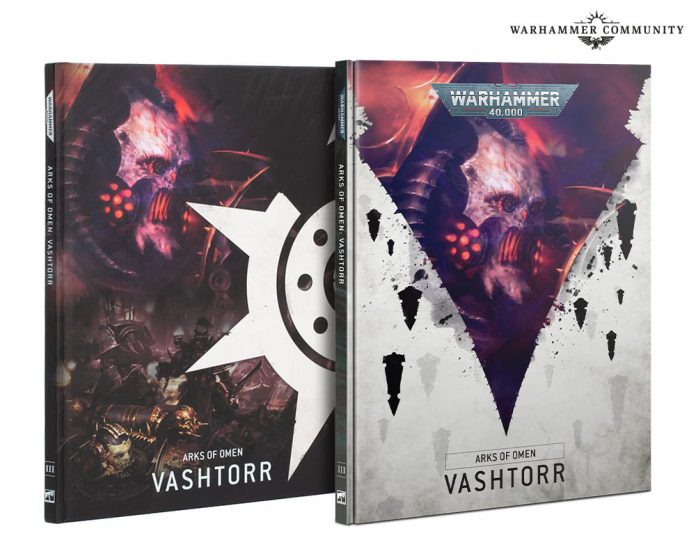It’s finally here! The third installment of the Arks of Omen series has launched with what is definitely some great lore for Chaos’s new kid on the block, the expected slate of boarding action rules, a boarding action campaign going through the chaos attack on The Rock, and new datasheets for both Big Azrael and Vashtorr which we’re sure will be really good and not at all disappointing.
Thanks to Games Workshop for providing us with a preview copy of the book for this review.
The Lore
Norman: Before getting into the lore here I gotta set the stage a bit. At the New Mexico Grand Narrative event I saw Vashtorr’s model get revealed live. I was instantly in love with the character. The motivations seemed neat, the angle for chaos dominion was cool, and the model ripped shit. I decided there and then I was ride or die Vashtorr.
Narrator: This was a mistake.
Norman: For those just joining the story, here’s what’s been happening so far; Vashtorr and Abaddon have teamed up to do some sort of secret plan that will result in Abaddon getting a powerful, Imperium destroying weapon and Vashtorr ascending to chaos god status. In order to accomplish this, they need to gather keys in order to… do something with them. Vashtorr creates the Arks of Omen, space hulks outfitted for war which are sent out by Abaddon to scour the galaxy for these keys.
The set up for this book is that Vashtorr needs to get into the Dark Angels super-spaceship, The Rock, in order to recover another MacGuffin for his master plan. After enlisting the help of an abominable intelligence and giving it its own Ark of Oomen, he locates The Rock and attacks it. Usually I’d just give my impressions from here to avoid spoilers, but I kind of need to get into specifics in order to really hammer home my thoughts so:
+++ SPOILERS AHEAD +++
This story actually starts setting up Vashtorr in an interesting way. You get insight into how Vashtorr works as a warp entity and get a handle for what “rules” he has to follow as a chaos demigod. Where Tzeentch might be focused on scheming and trickery or Slaanesh might be focused on beauty and perfection, Vashtorr is driven by curiosity and a desire to build and test. It has the bones for a strong chaos character that lets you see their strengths and shortcomings immediately. He even gets a sacred number, 5, although that’s not explicitly stated. If they wanted to make Vashtorr a chaos god – and I need to be explicit here, they won’t – there’s a clear path for how his faction would work and where he’d sit in the pantheon.
It’s important to note this isn’t just the Vashtorr show: everyone’s favorite chapter the Dark Angels [Condit Note: Stop pandering to Greg already] are here, too. They’re portrayed about how you’d expect, including Big Azrael making the scene complete with new Primaris drip. The First Legion have their characteristic grim resolve and Never Give Up-ittude on full display as they muster to ward off the invasion of Vashtorr’s forces.
Here’s where things go straight to shit alley.
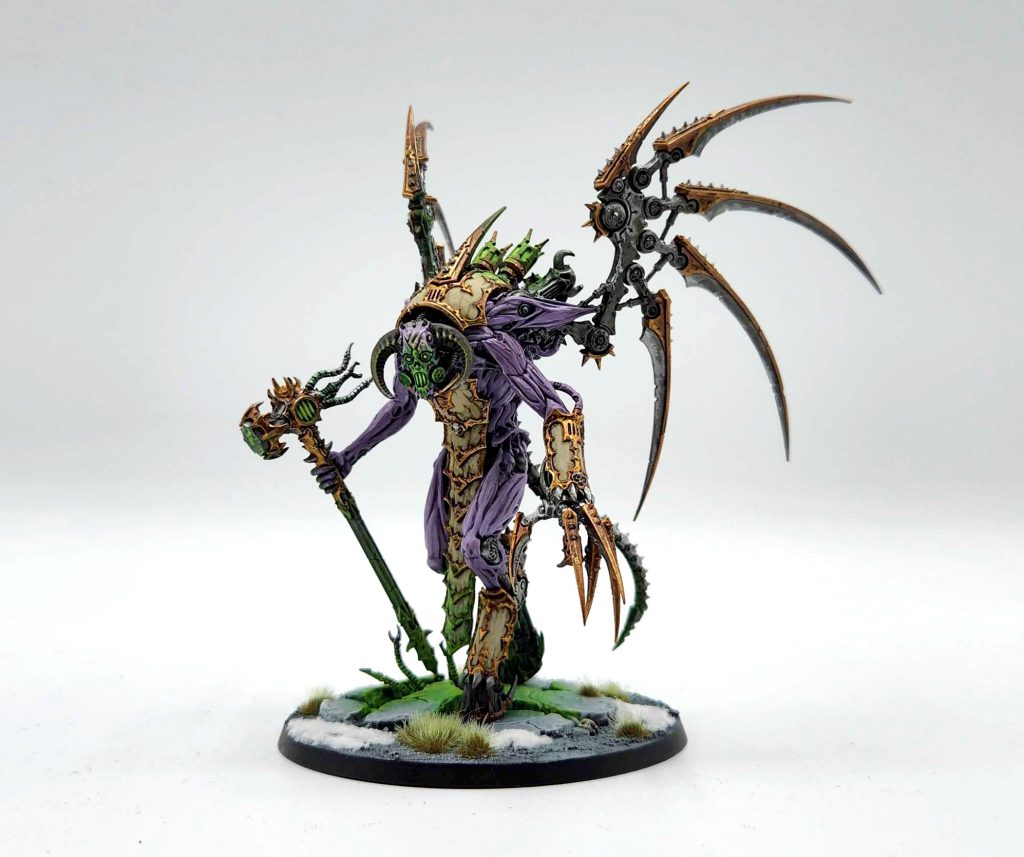
This book falls apart HARD about 25% of the way in. Starting with when Vashtorr and Azrael clash. Vashtorr is winning his fight against the Chapter Master of the Dark Angels pretty handily when Vashtorr is suddenly distracted by a power flux on The Rock. Because of his inherent curiosity, Vashtorr is compelled to investigate, giving Azrael a chance, not to land a cool heroic blow and change the tide of the fight, but instead to run away. That’s right, the chapter master of the Dark Angels, a chapter who has special rules for not being able to fall back, runs the fuck away from the daemon that is the source of all the problems on The Rock.
GREGNOTE: I know this looks bad, but consider that Big Azrael was just being Smart. He probably wasn’t even losing, he just had to go eat his lunch. Becoming a Primaris makes you a hungry boy, and he had a sandwich and some orange slices that his Watcher In The Dark was holding on to for him. Big Azrael was just going to have a snack, and then get right back to work. It’s not even really that bad, because Daemons don’t know about lunch so they get an unfair advantage in fighting. Big Azrael was just trying to level the playing field. It’s not his fault that they never got to finish.
Now what about that power fluctuation? Well, everyone’s least favorite first ever daemon prince has shown up to fuck everything up! Be’lakor comes in with his shadow army and they start indiscriminately firing on everyone. Be’lakor teleports Vashtorr away from the main fighting, saving Azrael and the rest of the Dark Angels down there, and starts beating his ass. It’s not one sided and Vashtorr holds his own to the point that Be’lakor says “I don’t know why you’re here but my only goal was to fuck up whatever weirdo plan you have, so I’m leaving now”. Vashtorr then takes control of every gun held by every war machine on The Rock and shoots Be’lakor and his posse with them. Be’lakor is sent back to whatever shadow hellhole he came from. Vashtorr then realizes the offensive is lost and retreats.
Ok. So this sucked big time. No one in the story walks away from this looking cool. Azrael ran away, Vashtorr stepped on every rake possible, and Be’lakor seems like an impudent child that’s sad for not being included. I’m really not sure what this book accomplishes. It gives no set up for future campaign books outside a vague “we gotta get THE THING” from Abaddon at the end. It doesn’t build excitement for the new character since he gets punked the whole time. It doesn’t make the Dark Angels look heroic for defeating an overwhelming enemy because they just luck into Be’lakor showing up. It’s nothing. As someone who’s ride-or-die Vashtorr, the ride is getting kinda bumpy here. At least we have cool rules for the model right? Right??
Greg: This is actually what you would consider “very good lore”. The gist is that a big scary monster shows up and tries to get buck with the Dark Angels, and they teach it some goddamn manners while showing it the door. The void battle, where the Rock throws down with a full-on Ark of Omen 1v1 and fights it to a standstill, is cool, but it’s when the fighting moves into the Rock itself where things get nuts. All your favorite Warhammer battles are here: Iron Warriors getting owned by Dark Angels, Black Legion getting owned by Dark Angels, even Daemons getting owned by Dark Angels. When Big Azrael makes his first appearance, still recovering from surgery, it’s to get insanely mad and bash the head off of some Black Legion yabbo. On one hand, this is another battle using the same “chaos invades the Rock and the Dark Angels slowly lose ground while winnowing them down“ template that we’ve seen at least twice before, but on the other hand, there’s a lot of Dark Angels killing people in this book, so it’s hard to get too upset about it.
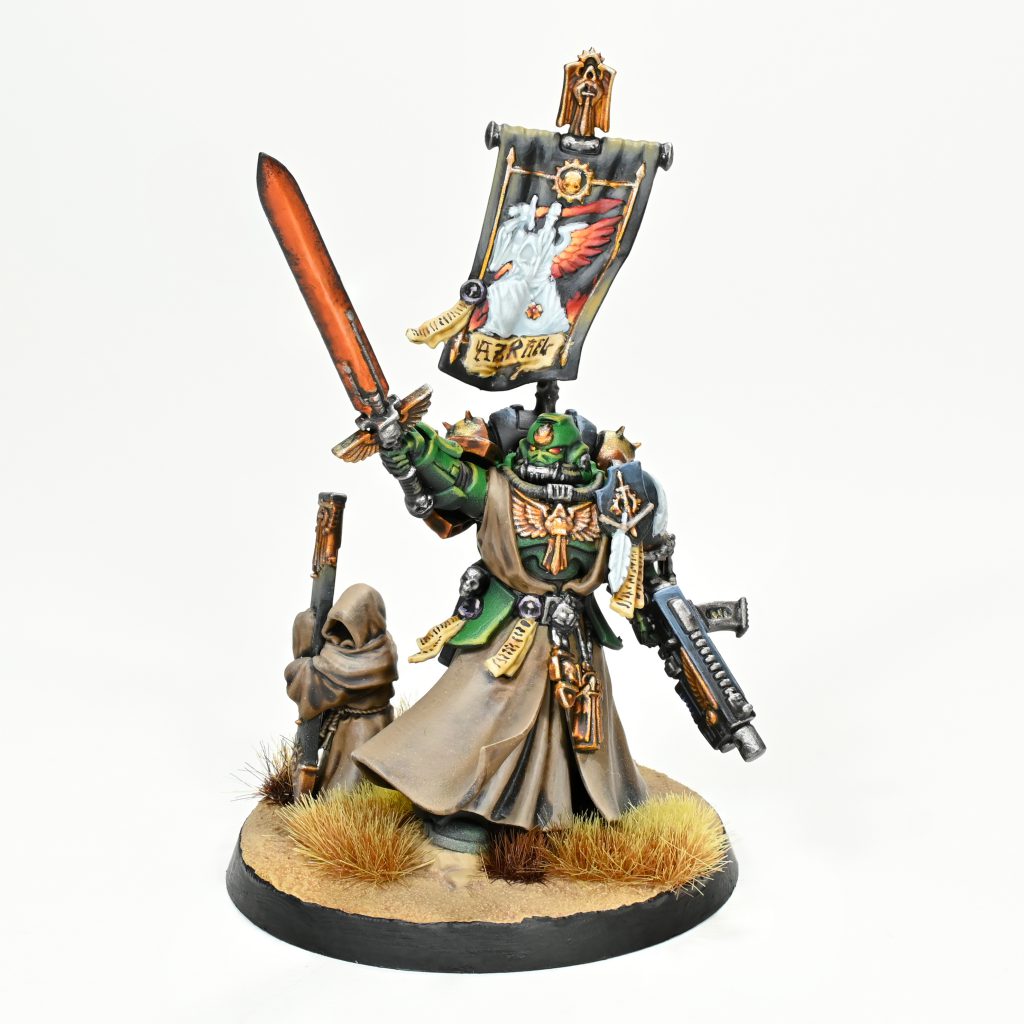
It’s cool that Vashtorr spent a bunch of time working on his little plan and setting all his cute traps, but he absolutely came to the wrong place to try and run that hustle. You can’t Home Alone the Dark Angels on their own turf, my guy.
It is, in the end, simply amazing how raw Vashtorr gets treated here, in his own book, where he is introduced, with his name and likeness on the cover. He’s present almost entirely to give Big Azrael someone to fight. He spends half the narrative getting distracted by random machines because he can’t not be connected to everything at all times, like a malfunctioning set of AirPods, and then for basically no reason at all gets chumped by Be’lakor. Be’lakor, who isn’t even supposed to be here, and didn’t need the heat to begin with, shows up midway through Vashtorr’s own book, and clowns on his schemes relentless. The capstone to all of this is Vashtorr calling up Abbadon, who is busy wrecking up a bunch of AdMech and absolutely does not have time for this weirdo. Abbadon bluntly tells Vashtorr to shut up and stop whining, because he’s sick of the daemon being such a failure all the time.
It’s honestly perplexing, the lack of respect Arks of Omen: Vashtorr seems to have for its title character, and we haven’t even gotten to the datasheet yet.
Norman: Oh god the datasheet.
Faction Rules
As usual in the Arks books, we get some faction rules for Boarding Activities. And, as usual, they’re all pretty good!
Chaos Daemons
Just like Chaos Marines in the last book, most of the rules here key off what god your Daemons are affiliated with, which will limit the number of options you have to you. Thankfully, a lot of these are pretty damn good. If your Warlord is a Khorne Daemon, you can give it the Unholy Fury enhancement to allow it to charge even in a turn when it advanced or charged. Meanwhile, a Tzeentch Daemon’s Incorporeal Form subtracts 1 from the wound roll of all incoming attacks.
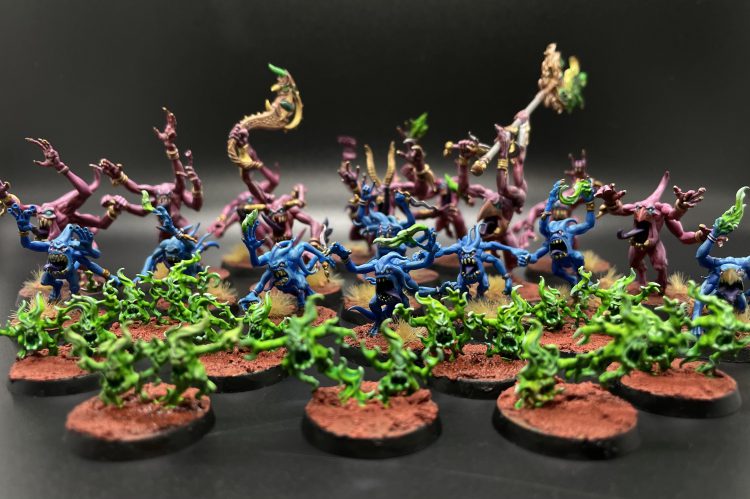
And just like Chaos Marines, your stratagems also largely look to your Daemons’ god keyword. Your Plaguebearers’ Revolting Constitution gives them the equivalent of the Space Marines’ Transhuman Physiology, and Slaanesh Daemons can lean into their Dark Allure to prevent enemies from taking actions or firing Overwatch, knock 2” off their Move, and halve advance and charge rolls in the bargain. But for my money, Mutable Form is the standout choice here: it allows you to swap your Warlord’s enhancement with another. Granted, you’ll only have one choice from this book, but several of the generic options in Abaddon only look better when you can swap to them when you need them.
On balance, Daemons will have fewer enhancements available to them than a similarly-aligned Chaos Marines force, but the extra flexibility they can squeeze out of their god-agnostic strats probably makes up for it. You’ll be just as well-equipped to squeeze every last bit of mileage out of your units’ strengths while simultaneously adapting to evolving situations. All in all, a very cool little set of rules.
Necrons
The Necrons come to the Arks of Omens with some nasty tricks. Having trouble getting your Skorpekh Lord through the twisting corridors of the space hulk and into combat? Look no further than the Nanoweave Phase Shifter, which lets the model holding it move through models, walls, and closed hatchways for a single movement phase. It has to end in a position that would otherwise be legal, but this is a great trick for traversing the board to get off a sneaky charge or pop onto an objective a turn or two before your opponent expects it. Meanwhile, if you’re playing without the dataslate, you may find that the one-Noble restriction and inability to trace line-of-effect through terrain makes your Command Protocols very difficult to get mileage out of. Enter the Mindmesh Command Node, which lets your entire force benefit from your active Command Protocol so long as the bearer is on the table. It’s completely obsolete in games with the dataslate, but incredibly useful in games without it.
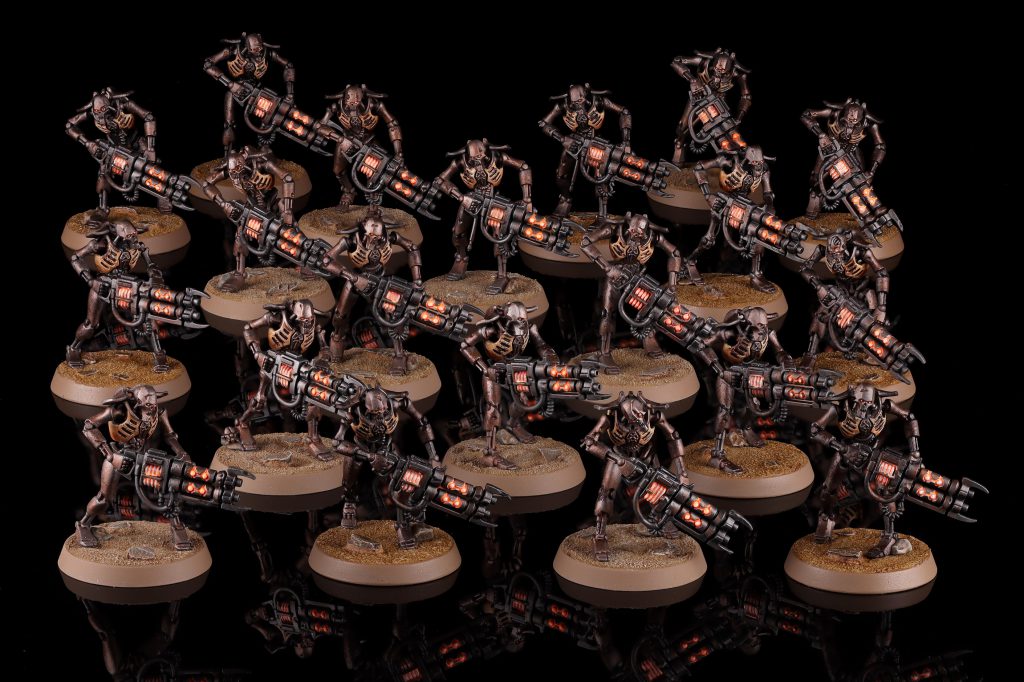
Their stratagem support is also top-notch. Resurrection Protocols is back, giving you a chance to have your character come back from the dead once per game, and the new Rapid Reanimation lets your add 1 to reanimation protocols rolls for a unit for a phase, and if you use your mustering rules to bring a Cryptek, it only costs 1CP. And if you’re looking to get some killing done, Shield-Piercer Projectors lets a single model ignore invulnerable saves in the shooting phase, while Disruption Fields adds 1 to the strength of one of your units in the fight phase.
Necrons in boarding actions have some pretty nasty tricks that make them tougher to kill while simultaneously letting them dish out some serious pain in the spots where they need to. Necron Warriors and Immortals under the effects of Rapid Reanimation are that much harder to put down unless you overcommit, and a Cryptek with Shield-Piercer Projectors can be a serious threat to your key pieces. These rules are reasonably powerful, fun to play with, and solidly flavorful. A solid win across the board.
Tyranids
Tyranids come to Boarding Actions with a suite of powerful rules. Enhancements like Hunter’s Instincts, which lets you charge around corners, and Shadow Connection, which lets you give out buffs to anyone on the board regardless of how many walls are in the way, let you ignore some of the biggest challenges players have to maneuver around in the format.
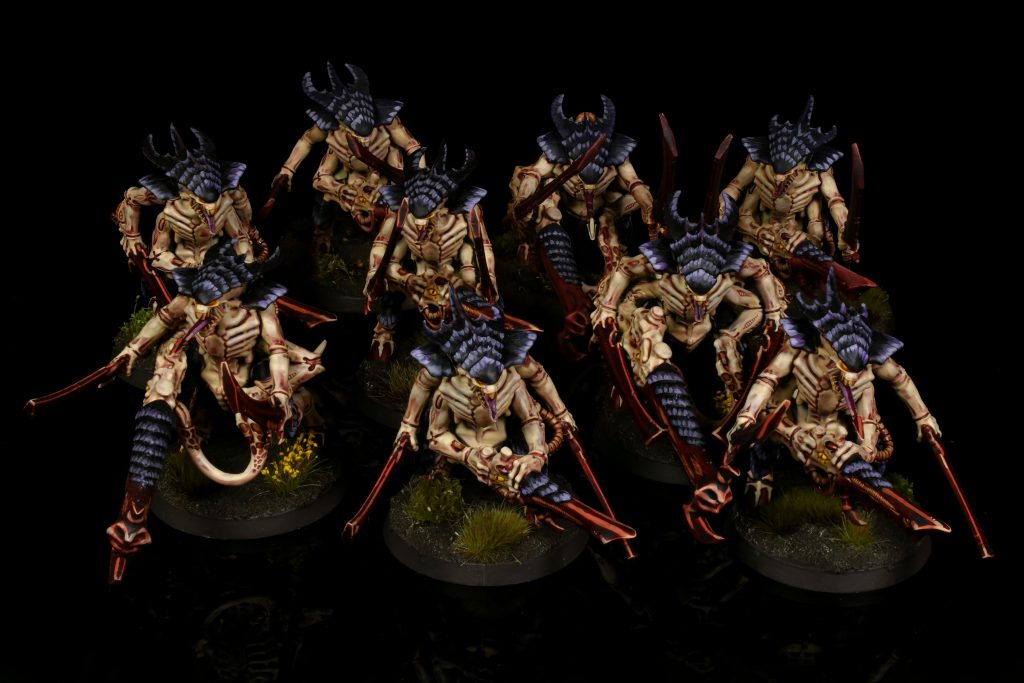
On the stratagem side of things, there’s some good emphasis on running Endless Multitude units: Living Rams lets them move right through a hatchway, opening it up on the way, while Ravenous Tide allows any unit to fall back and charge, but if you do it with an Endless Multitude unit, it can move over models as if they weren’t there. Or if you’d prefer some larger bugs in your boarding patrol, for just 1CP Layered Chitin knocks 1 off the strength of all attacks made against models with more than 1 starting wound.
Overall, these rules let Tyranids play the board in a way that other factions will struggle to compete with, and back up their hordes of ‘gaunts with some particularly nasty larger critters. Canny Nids players will be able to make good use of these rules to give nearly anyone a run for their money.
Genestealer Cults
Honestly, the rules here are a bit of a let down from a narrative perspective. Boarding Actions games are rife with opportunities to let players set up booby traps and ambushes in really cool and flavorful ways, but unfortunately we get none of that here. Instead, Genestealer Cult players will have to make do with the standard fare of admittedly solid enhancements and stratagems.
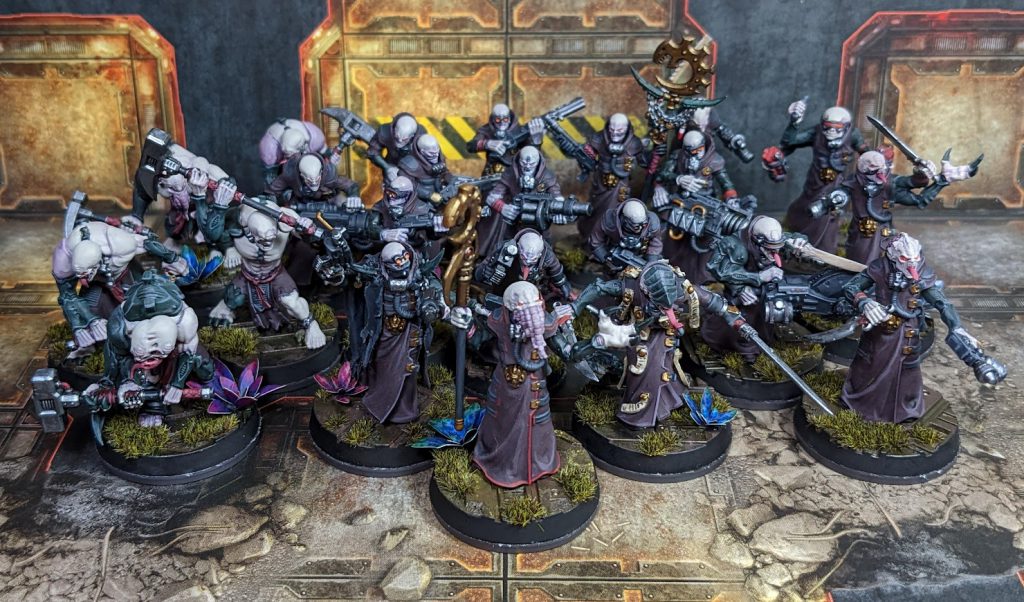
Speaking of enhancements, the standout is probably Alien Regality, which increases the range of your auras and Meticulous Planner abilities by 3”. It may not be flashy, but that extra range is very useful for getting your abilities around those pesky walls and corners. Then again, if you’re looking for flashy, look no further than Instinctive Counterstrike, which allows a unit within 9” of your Warlord to heroically intervene up to 6”. This is, unfortunately, very situational given that you have to be able to see your target unit to intervene on them, but could be very nasty when that situation shows up.
Your stratagems are a nice mix of returning and new effects. Monstrous Vigour lets you hand out transhuman to Aberrants or Abominants, while Shadow Dwellers lets a unit in cover gain an additional +1 to their save. You’ll also have access to Insidious Infiltration, which lets you deep strike a unit of Genestealers by putting them in the vents of a ship, while Vicious to the End allows a unit to fight on death, which is very nice for if you get caught out of position with some of your melee threats.
In the context of every other faction, the Genestealer Cults have a solid and flavorful set of rules that players will likely have a lot of fun with. It’s just a shame that they didn’t get some more tricks to sell their particular flavor.
Death Guard
Death Guard are mostly just bringing back rules from their Codex, but that’s certainly welcome here. Chief among those is the ability to pick a contagion from the book and give it to your warlord with the Plague Vector enhancement. Or if you were looking for some more durability, consider Plentiful Pustulance, which lets you ignore wounds on a 5+.
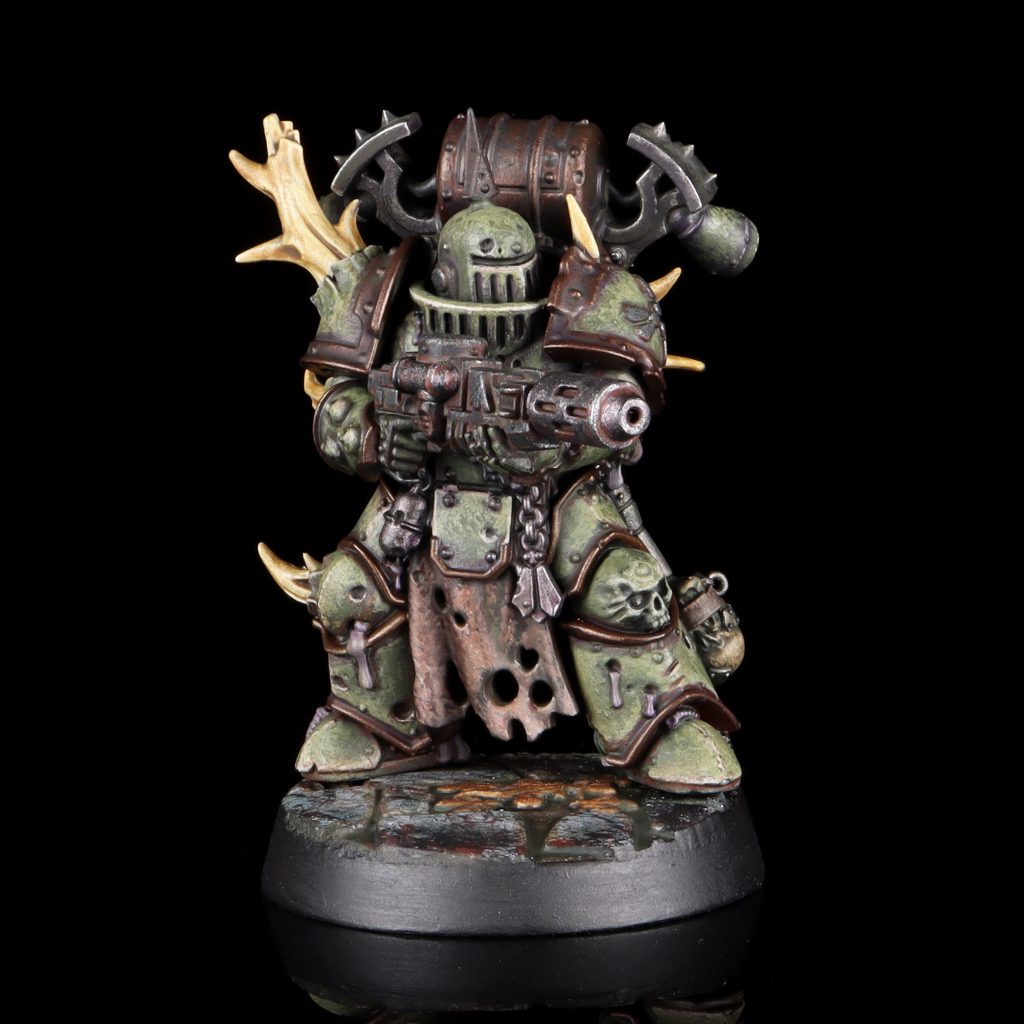
On the stratagem side of things, there’s some really strong stuff here. Blade-Borne Infectors lets a unit score 2 hits for every unmodified 6 rolled to hit, and Cloud of Flies gives a unit of BUBONIC ASTARTES cover for the turn. There are a few returning stratagems as well, but the star here is Rain of Blights: it’s just reskinned Blight Bombardment from the Codex, but it turns out that that’s a pretty damn good effect.
The rules here are nothing you didn’t expect, but that’s fine: they’re still solid. The extra tricks you pick up here definitely go a long way to making your boarding patrols “feel” like Death Guard without making them completely overwhelming for your opponent to deal with.
Adeptus Mechanicus
Want to open a door, but don’t feel like going near it? The Cogitator Override Node has you covered. This sleek little universal remote control lets your Tech Priest open or close hatchways from 9” away, and even lets you throw your model’s Strength into it if your opponent tries to hold it shut. If you’ve brought a Skitarii Marshal, he can have the Skull of Komodus tag along with him, allowing him to hand out full to-hit rerolls to a Skitarii Core unit within 6”. Neat!

The stratagems are, broadly speaking, not particularly interesting. That doesn’t mean they’re bad, though: Omnissiah’s Shield lets you hand out a 4+ invulnerable save to a model, while Infoslave Skull lets a unit that has Set Overwatch also Hold Steady to hit on 5+. On the more interesting side, Electro-Priests and Tech Priests can summon the Power of the Motive Force to subtract 1 from all incoming hit rolls and remove the opponent’s ability to re-roll them, while Sicarians can advance and charge and change their pistol weapons to Assault for a turn.
Taken together, this is a combination of some interesting combat tricks with some fairly standard, if somewhat uninspiring, boosts to your survivability and damage output. All in all, you could do worse, and this will put AdMech players on solid footing in the Arks of Omen.
The Missions
In contrast to the Abbadon and Angron missions the Vashtorr missions are structured as a campaign retelling the battle for The Rock. It’s worth noting that neither Vashtorr nor Be’lakor can appear in a boarding action mission so it’s kinda an odd approach for it but that’s fine. There’s some cool ideas in here but I really don’t think it’s worth playing these missions on their own as many of the mission outcomes impact future missions.
This book also has rules for using the Killzone Shadowvaults upgrades in your boarding action games which is nice to see. What’s not so nice to see is that, instead of having easy rules for how to deploy these in normal missions, there are set locations to put these if you pay for them in your list. None of these are particularly powerful, but they can be nice list fillers. The standout here is the humble Searchlight, which gives a unit reroll 1’s against something within line of sight and 9” of it.
As for the missions themselves it’s much of what you would expect, with rules for taking down Geller fields, which allow for armies to deep strike in later missions, or giving bonus CP for stopping your opponent from doing actions or completing objectives in a previous mission. The missions themselves are a little vanilla for what could have been such a cool set-piece, but they do include some neat twists like having teleporters between parts of the ship or booby-trapping certain hatchways. Overall, unless you want to run the campaign front to back, this mission set is very skippable. That said, there are neat ideas in here that can be lifted into an ongoing crusade campaign or incorporated into later stuff, but honestly the White Dwarf stuff they’ve been putting out has been better.
The Datasheets
Norman: It’s so bad you guys. It’s so much more fucked up than you could ever imagine.
Condit: Shut up, Norman. This is a No-Whining zone, unless it’s whining about how Dark Angels get a revamped character and I’m still stuck with one guy from Clan Raukaan, the Clan Which Sucks.
Greg: Counterpoint, this absolutely rules. Azrael got diesel and I’m here for it.

Norman: Despite Iron Hands players making up like 5% of the meta, no one knows what you’re talking about, Condit.
Condit: You know what, fair.
Norman: We’ll start with Vashtorr. Let me walk you all through my experience looking at this bastard’s datasheet:
Statline looks serviceable. S7, T7, 6 attacks. 14 wounds means he can’t be Look Out Sir’d, which is fine. Not really the statline of a combat character, but he’s probably meant to be more technical and those attacks are probably pretty cool.
On to the weapons. We have Vashtorr’s Claw, which is just a heavy flamer with extra AP and no melee profile. That’s fine though, he can punch with Vashtorr’s Hammer, which is Sx2 AP -2 D3. That’s right, AP -2. It’s got an ability to do 4 mortals instead, on a wound roll of 5+ and only against vehicles, but that’s both a corner case and very whiffable. Ok, fine, so the manifestation of the machine god’s will is a fancy thunder hammer. Not even a heavy thunder hammer. That’s fine, he exists for his abilities, surely.
GREGNOTE: I just want to echo here how objectively hilarious it is that Vashtorr’s Claw, which is the laziest name they could possibly have come up with here, doesn’t have a melee profile at all. It’s a huge talon that’s like 8 feet long, and literally cannot be used to hit people. This sucks, man.
He’s got 3 abilities. The standard Warp Strike (sure), Body of Unholy Artifice to give him a 4++ and -1 damage (solid, but a little odd considering he’s a daemon without a daemon save), and Will of the Arkifane. That last ability lets you pick one of three modes in the command phase (keep this in mind). Unholy Mechanisms lets you pick a Daemon Engine within 3” (it can’t be a CHARACTER, AIRCRAFT, or TITANIC) and gives it +1 to hit, Ghost in the Machine lets you pick an enemy in 18” and halve the range on their weapons, and Agonise Machine Spirit halves the move and attacks of an enemy vehicle within 18”. These are all terrible.
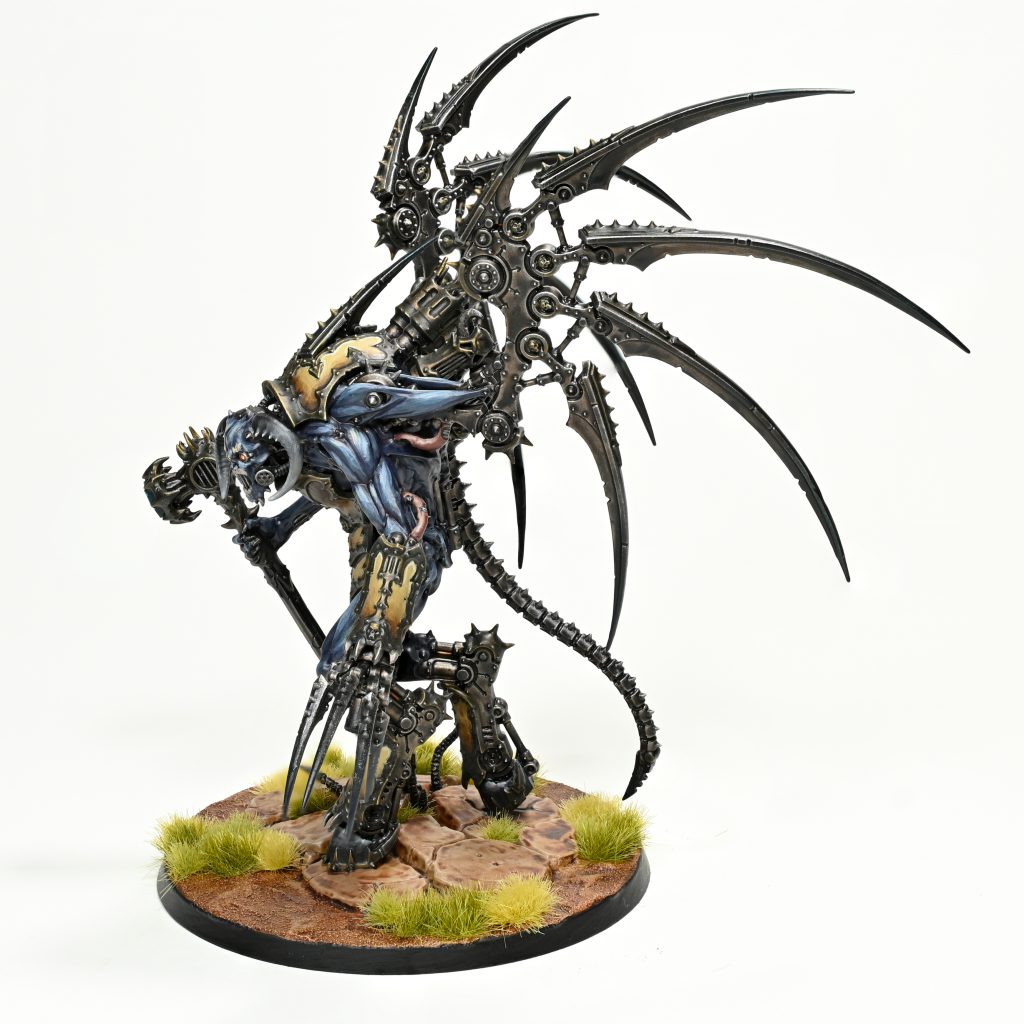
Unholy Mechanisms ends up being a worse version of what the Lord Discordant or Warpsmith can do because of the limitations on the small wedge of units it can apply to. Some may say “oh but you get a blanket +1 to hit, you don’t have to worry about ranged vs melee” to which I say, when you build your list you know exactly what your daemon engines are going to be doing. Forgefiends want +1 to hit in shooting while +1 to hit in melee doesn’t matter, the opposite is true for a maulerfiend. Ghost in the Machine looks good on paper, but there are VERY few things in the game that, after having their range halved, can’t just move up and shoot Vashtorr anyway, because he’s within 18” before casting this. Anything you wanted to use this on will have ended its turn in line of sight to Vashtorr who will almost certainly have killed him. Agonize Machine Spirits is ironically most useful against melee daemon engines and Chaos Knights and is kind of just whatever.
As a final cherry on top, if you take Vashtorr as your warlord he has to take Lord of Terror from the Chaos Space Marines book, the worst trait possible, and the moron is 260 points. I would pay at most 180 for this bozo and that’s being generous
He’s awful. Just fucking terrible. He doesn’t kill a Redemptor Dreadnought on average, he doesnt kill a Leman Russ either. So he can’t kill the things he’s the god of and his abilities don’t even stop them from shooting him to death. He can only buff a small wedge of vehicles despite being lord of all machines. This datasheet is frustration incarnate. I am contractually obligated to use the line Rob said in our discussions, He is the god of the fucking dumpster.
Azrael, on the other hand is fine. He’s a direct upgrade with +1 to his wounds, attacks, and strength and damage on the Sword of Secrets. He’s exactly what you want him to be.
Greg: It’s insanely funny how dirty they did Vashtorr, but also no one cares about the idiot wrench god.
Big Azrael now gets 6 swings at 7/-4/3 (up from 5 at 6/-4/2), which rips. You still get the 4++ bubble, though it’s slightly bigger now that he isn’t on a piddly little 25mm base. His PL didn’t actually change, and there aren’t points in here, but Warhammer Community posted his datasheet and he costs 170 now. That is still a friggin’ bargain for what you’re getting here.

The reason Big Azrael is so good now despite only minor actual changes is that he was already good – Dark Angels have been on a tear lately, which as you may recall I did predict, and a good chunk of those lists have Azrael in them. Dark Angels didn’t need the help, but they got it anyway, because they deserve it, for being the best. I’m actually fine with the relatively minor glow up, because Big Azrael still does the same stuff as before, he’s just slightly better at it.
Also, if you’re thinking about re-enacting the narrative here, Big Azrael and Vashtorr ends up being a hilariously even fight – they have the same number of attacks, and both of them hit each other on 2s, wound on 4s (Azrael due to his new S7 sword, and Vashtorr because of Azrael being Inner Circle), and save on 4s. There’s a few tricks Big Azrael has to even the score, like being in the Assault doctrine and re-rolling all of his wounds, or being the only one in the fight with a gun that’s actually good, but at the end of the day it’s not enough to overcome Vashtorr’s deeper wound pool. You know what else has a deep pool of wounds and can’t really do much damage? A punching bag. Also, Big Azrael can Deny the Witch once a game, which would matter if Vashtorr were a psyker. He isn’t, because he sucks, and I only bring this up to reinforce how much nobody likes Vashtorr.
Still, on average dice Big Azreal will canonically die but also weaken the hell out of Vashtorr, which is fine because he also costs like half the points and is not technically a God, so you have to grade him on a little bit of a curve.
Norman: Ugh this sucks. Stupid bad game.
Final Thoughts
Norman: Everything is terrible and I hate it.
Greg: This is the best book GW has ever published, and probably in the top 5 of all books ever written across human history. The only thing that keeps it from being absolutely perfect is the title: if this had been “Arks of Omen: Azrael” it would somehow have been even better than it already is.
Condit: For everyone other than Norman and Greg, though, this book will be pretty neat, I guess. If you’ve been hankering to get one of the factions whose rules are included here into a boarding actions game, the offerings here are all at the minimum solid options that are evocative of their
If you’re picking this up for the missions, it’s fine. Some of them are fine standing alone, though several of the missions here seem like they were written without really considering that someone might play them outside the context of the suggested campaign structure, and they suffer a bit for that. That said, outside of some scoring quirks, none of them really seem like they’d be horrible to play, and adding some more lopsided missions is neat.
At the end of the day, if you don’t play one of the factions contained in this book, are you going to regret the purchase? Probably not. Unless you’re “ride-or-die” for Vashtorr, but at that point, really, you’ve brought this on yourself.
For those of you that are on the Vashtorr train, though, stay tuned: GW have released rules for the Cult of the Arkifane, an Army of Renown just for Boarding Actions made up of mortals devoted to Vashtorr. We’ll have a review of that coming this week.
